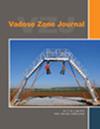模拟氮肥对南印度玉米、小指米和马铃薯作物水循环和用水效率的影响
IF 2.8
3区 地球科学
Q3 ENVIRONMENTAL SCIENCES
引用次数: 0
摘要
了解氮(N)肥对田间水循环和相应的水分利用效率(WUE)的影响对于优化施肥量和保护紧张的水资源非常重要。我们使用校准过的 HYDRUS-1D 模型,在两个实验点(雨水灌溉和灌溉)对玉米(Zea mays L.)、小米(Eleusine coracana Gaertn.)和马铃薯(Lablab purpureus (L..) Sweet)地块进行了三季不同氮肥处理下的土壤水分动态建模。结果表明,氮的影响取决于植物的具体特性,如固氮能力和耐旱性,以及受土壤结构和降雨季节变化影响的植物可用水量。在两个试验中,每公顷施用 150 千克尿素(46 N)的地块的玉米水分利用效率比未施用尿素的地块高 10-30 千克/公顷/毫米;同样,每公顷施用 50 千克尿素的小米的水分利用效率比对照地块高 7-10 千克/公顷/毫米。然而,只有在雨水灌溉试验中,不同氮处理之间的水循环成分差异明显,较高的氮水平导致玉米和小米每季蒸腾量分别增加约 60 毫米和 30 毫米,蒸发量分别减少 30 毫米和 20 毫米,渗滤量分别减少 30 毫米和 15 毫米。2018 年是最干旱的一年,高氮处理和低氮处理之间的玉米水分利用效率差异仅为 1 千克/公顷/毫米,这与实际蒸腾量与潜在蒸腾量的低比率()相对应。这表明玉米对水分胁迫的敏感性高于其他作物。马铃薯的研究结果表明,只有在水分有限的条件下,氮肥才会对水分利用效率产生积极影响。本文章由计算机程序翻译,如有差异,请以英文原文为准。
Modeling N fertilization impact on water cycle and water use efficiency of maize, finger‐millet, and lablab crops in South India
The understanding of the impact of nitrogen (N) fertilization on the field water cycle and corresponding water use efficiency (WUE) is very important for optimizing fertilization rates and conserving stressed water resources. We modeled soil moisture dynamics of maize (Zea mays L.), finger millet (Eleusine coracana Gaertn .), and lablab [Lablab purpureus (L..) Sweet ] plots using calibrated HYDRUS‐1D model on two experimental sites (rain‐fed and irrigated) for three seasons under different N treatments. The results indicate that the effects of N depended on plant specific properties such as N‐fixation and drought tolerance, and on plant available water content governed by soil structure and rainfall seasonal variability. Maize WUE of plots which received 150 kg/ha of urea (46 N) were 10–30 kg/ha/mm higher than plots which received none; likewise, millet that received 50 kg/ha of urea had a 7–10 kg/ha/mm higher WUE than control plots in both experiments. However, differences in water cycle components were noticeable between N treatments only in the rain‐fed experiment, where higher N levels led to around 60 and 30 mm higher transpiration, 30 and 20 mm lower evaporation, and 30 and 15 mm lower percolation per season for maize and millet, respectively. In 2018, which was the driest year, the difference in maize WUE between the high and low N treatments was only 1 kg/ha/mm, which corresponded with low actual to potential transpiration ratios (). This indicates higher sensitivity of maize to water stress compared to the other crops. The results of lablab indicate a positive impact of N fertilization on WUE only under water‐limited conditions.
求助全文
通过发布文献求助,成功后即可免费获取论文全文。
去求助
来源期刊

Vadose Zone Journal
环境科学-环境科学
CiteScore
5.60
自引率
7.10%
发文量
61
审稿时长
3.8 months
期刊介绍:
Vadose Zone Journal is a unique publication outlet for interdisciplinary research and assessment of the vadose zone, the portion of the Critical Zone that comprises the Earth’s critical living surface down to groundwater. It is a peer-reviewed, international journal publishing reviews, original research, and special sections across a wide range of disciplines. Vadose Zone Journal reports fundamental and applied research from disciplinary and multidisciplinary investigations, including assessment and policy analyses, of the mostly unsaturated zone between the soil surface and the groundwater table. The goal is to disseminate information to facilitate science-based decision-making and sustainable management of the vadose zone. Examples of topic areas suitable for VZJ are variably saturated fluid flow, heat and solute transport in granular and fractured media, flow processes in the capillary fringe at or near the water table, water table management, regional and global climate change impacts on the vadose zone, carbon sequestration, design and performance of waste disposal facilities, long-term stewardship of contaminated sites in the vadose zone, biogeochemical transformation processes, microbial processes in shallow and deep formations, bioremediation, and the fate and transport of radionuclides, inorganic and organic chemicals, colloids, viruses, and microorganisms. Articles in VZJ also address yet-to-be-resolved issues, such as how to quantify heterogeneity of subsurface processes and properties, and how to couple physical, chemical, and biological processes across a range of spatial scales from the molecular to the global.
 求助内容:
求助内容: 应助结果提醒方式:
应助结果提醒方式:


